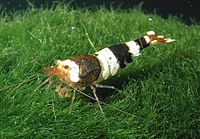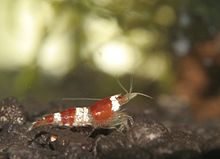Bee shrimp
| Bee shrimp | ||||||||||||
|---|---|---|---|---|---|---|---|---|---|---|---|---|

Bee shrimp, red color form "Crystal Red" |
||||||||||||
| Systematics | ||||||||||||
|
||||||||||||
| Scientific name | ||||||||||||
| Caridina Logemanni | ||||||||||||
| Klotz & von Rintelen , 2014 |
The bee shrimp ( Caridina logemanni ) is a freshwater shrimp (Atyidae) from the genus Caridina originating from Hong Kong . Because of its attractive appearance and its relatively unproblematic keeping, it is often kept in aquariums . A red color variant is traded under the name "Crystal Red" or "Crystal Red Dwarf Shrimp".
Appearance
The bee shrimp reaches a length of about two centimeters, female animals are usually slightly larger than their male counterparts. Adult females appear fuller overall and their abdomen is drawn out deeper. Both sexes have a pattern of black and two to four white to transparent horizontal stripes on the abdomen . The color variation Crystal Red lacks black pigment cells, which is why it shows a strong red instead of the brownish-gray basic color of the normal form. As with all dwarf shrimp, the color and pattern can vary greatly even within a population. A more reliable determination is possible using the rostrum formula 4-7 (4) + 6-14 (8) / 1-3 (2).
Cultivated forms
Various new color forms have been bred from the bee shrimp in recent years. It is not entirely clear whether all forms were created through classical breeding and selection or partly through crossing with other species.
Way of life
The bee shrimp is peaceful and feeds on growth on stones and rotting plant material as well as very small insect larvae.
The maximum life expectancy of the bee shrimp is one to one and a half years.
Reproduction
Mating occurs immediately after the female molts. It is turned on its back by the male, which, together with the inner branches of the first pair of swimming legs, which have been transformed into mating organs, places a spermatophore near the sexual opening of the female.
A few hours after mating, the 15 to 50 eggs, approximately 1 × 0.7 millimeters in size, are ejected from the ovaries and fertilized when they emerge from the genital opening. The female attaches them to the swimming legs, the pleopods , where they are supplied with oxygen-rich water through frequent movement. The clutch remains with the female for the entire incubation period, only unfertilized eggs are shed after a few days. Depending on the water temperature, the larvae hatch after three to four weeks. The one and a half millimeters large cubs are already very similar to their parents in terms of shape and color.
Systematics
Although the bee shrimp has been known, bred and traded for some time, its species affiliation is not yet fully understood. The greatest similarities with their microscopic identifying features can be found in Caridina trifasciata . However, since the morphological and genetic characteristics of the different breeding lines of the bee shrimp are subject to strong fluctuations and this variability has also been determined for the widespread Caridina cantonensis , the bee shrimp will be placed in the vicinity of this species for the time being.
The color variation Crystal Red was probably bred from a small number of red individuals by the Japanese shrimp breeder Hisayasu Suzuki since 1996.
literature
- Andreas Karge, Werner Klotz: Freshwater prawns from all over the world , Dähne Verlag, Ettlingen 2007, ISBN 978-3-935175-39-5
- Werner Klotz, Chris Lukaup: "Crystal Red" - The crystal red bee shrimp in Aquaristik aktuell, 3/2005, Dähne Verlag, pp. 34-38, ISSN 0947-6512
- Andreas Karge: Dwarf shrimp, part 2: Attempt to identify bee shrimp (A1 / 10) , the aquarium, 10/2002, Birgit Schmettkamp Verlag, ISSN 0341-2709 , pp. 12-17
Individual evidence
- ↑ W. Klotz & Th. Von Rintelen: To “bee” or not to be - on some ornamental shrimp from Guangdong Province, Southern China and Hong Kong SAR, with descriptions of three new species. In: Zootaxa , Vol. 3889, No. 2, pp. 151-184, 2014. doi: 10.11646 / zootaxa.3889.2.1
- ↑ [1] Description of the Crystal Red in the working group "Inland Waters Invertebrates"








